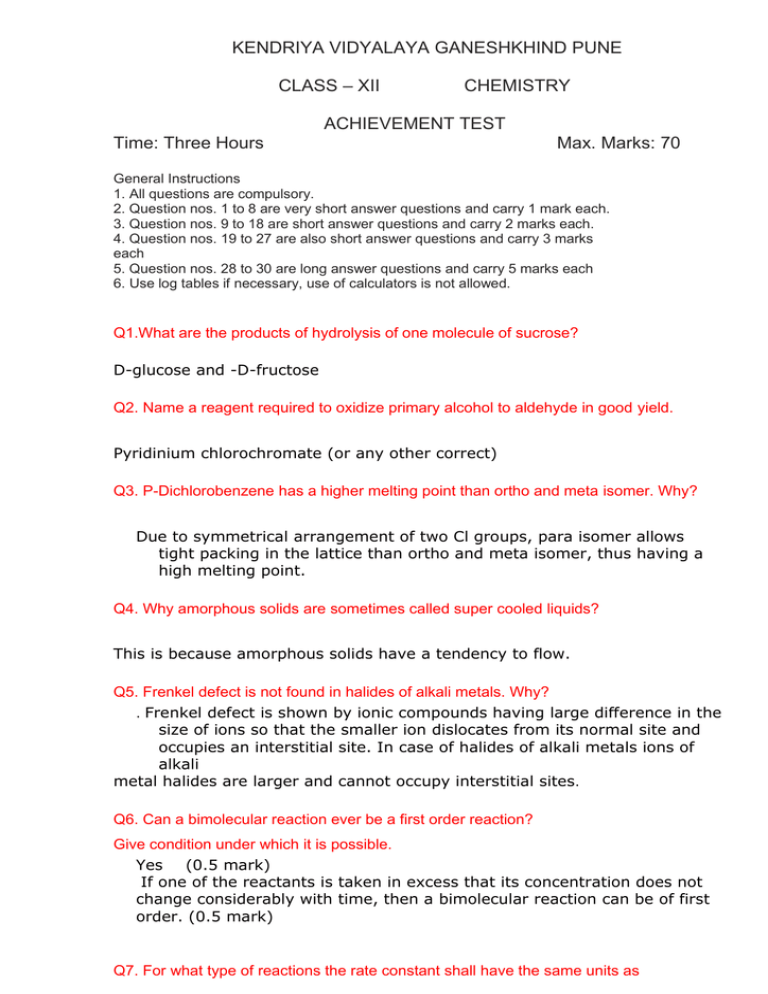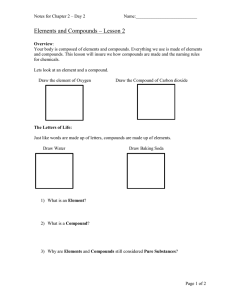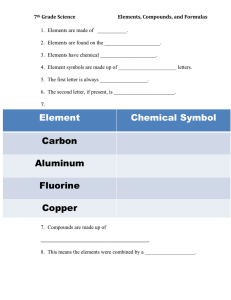xii ach exam 2011
advertisement

KENDRIYA VIDYALAYA GANESHKHIND PUNE CLASS – XII CHEMISTRY ACHIEVEMENT TEST Time: Three Hours Max. Marks: 70 General Instructions 1. All questions are compulsory. 2. Question nos. 1 to 8 are very short answer questions and carry 1 mark each. 3. Question nos. 9 to 18 are short answer questions and carry 2 marks each. 4. Question nos. 19 to 27 are also short answer questions and carry 3 marks each 5. Question nos. 28 to 30 are long answer questions and carry 5 marks each 6. Use log tables if necessary, use of calculators is not allowed. Q1.What are the products of hydrolysis of one molecule of sucrose? D-glucose and -D-fructose Q2. Name a reagent required to oxidize primary alcohol to aldehyde in good yield. Pyridinium chlorochromate (or any other correct) Q3. P-Dichlorobenzene has a higher melting point than ortho and meta isomer. Why? Due to symmetrical arrangement of two Cl groups, para isomer allows tight packing in the lattice than ortho and meta isomer, thus having a high melting point. Q4. Why amorphous solids are sometimes called super cooled liquids? This is because amorphous solids have a tendency to flow. Q5. Frenkel defect is not found in halides of alkali metals. Why? . Frenkel defect is shown by ionic compounds having large difference in the size of ions so that the smaller ion dislocates from its normal site and occupies an interstitial site. In case of halides of alkali metals ions of alkali metal halides are larger and cannot occupy interstitial sites. Q6. Can a bimolecular reaction ever be a first order reaction? Give condition under which it is possible. Yes (0.5 mark) If one of the reactants is taken in excess that its concentration does not change considerably with time, then a bimolecular reaction can be of first order. (0.5 mark) Q7. For what type of reactions the rate constant shall have the same units as the rate of reaction? Zero order reaction Q8. P4O10 is a well known dehydrating agent, but cannot be used for drying Ammonia. Why? P4O10 reacts with moist ammonia forming ammonium phosphate. Thus cannot be used for drying ammonia. Q9. [Co(NH3)6]3+ is diamagnetic while [CoF6]3- is paramagnetic. Why? (Atomic Number of Co =27) Paramagnetic. Q10. In a cell reaction, the equilibrium constant Kc is less than one. (a)Is E0 for the cell positive or negative? (b) What will be the value of Kc if E0cell =0? Q11. On mixing equal volumes of equimolar yellow colloid of As2S3 and brown Fe(OH)3, a colourless solution is formed. Explain. Q12.What type of graph is obtained when temperature is plotted against x/m for physical and chemical adsorption? Q13. Give reason for the following: (a) Chlorine water acts as a bleaching agent (b)Ozone gas leads to liberation of violet vapours when added to KI. Q14. What happens when tert-Butyl methyl ether is made to react with HI? Give reasons. Q15. Give a chemical test to distinguish between methanol and ethanol. Q16. Which of the two has higher pkb value and why? CH3CONH2 or CH3CH2NH2 Q17. Differentiate the following pair of polymers based on the property mentioned against each. (i) Novolac and Bakelite (structure) (ii) Buna-s and Terylene (intermolecular forces of attraction) Q18. 25. Write short notes on: a. Gabriel phthalimide synthesis b. Hoffmann bromamide degradation method a. Gabriel phthalimide synthesis is used for the Q19. a) Why are carbohydrates generally optically active? b) Two strands of DNA are complementary to each other. Account for it? c) Why is sucrose known as invert sugar? Q20. Write the reactions which take place in the mercury cell. For what type of devices can we use mercury cell? Q 21. a) Convert: (i)Ethanal to Crotonaldehyde (b) Draw structure of methyl hemiacetal of formaldehyde. (c) How do carbonyl compounds react with sodium hydrogen sulphite. Q22.Give reasons (a)Interhalogen compounds are more reactive than halogens. (b) Noble gases form compounds with fluorine and oxygen only. (c) Oxygen molecule has the formula O2 whilst sulphur molecule is S8. Why? Q23.A solution of [Ni(H2O)6]2+ is green but a solution of [Ni(CN)4]2- is colourless.Explain. Q24. What is paracetamol? Give its structure. Mention two medicinal effects it can have on human body. Q25.(a) What is the role of Benzoyl peroxide in polymerization of ethene? (b) What are LDPE and HDPE? How are they prepared? Q26(a) Amylose and cellulose both are straight chain polysaccharides containing only Dglucose units. What is the structural difference between the two? (b)Why does milk get coagulated when lemon juice is added to it? Q27. An organic compound A with molecular formula C4H9Br on treatment with alcoholic KOH gave two isomeric compounds B and C with the formula C4H8. On ozonolysis, B gave only one product CH3CHO while C gave two different products. Identify the compounds A, B and C. OR An organic compound (A) having molecular formula C9H10O forms an orange red precipitate (B) with 2, 4 – DNP reagent. Compound (A) gives a yellow precipitate (C) when heated in the presence of iodine and NaOH along With a colourless compound (D). (A) does not reduce Tollen’s reagent or Fehling’s solution nor does it decolorize bromine water. On drastic oxidation of (A) with chromic acid, a carboxylic acid (E) of molecular formula C7H6O2 is formed. Deduce the structures of the organic compounds (A) to (E). Q28. 28 a. Define the following terms: i. Mole fraction ii. Van’t Hoff factor b. 100 mg of a protein is dissolved in enough water to make 10.0 mL of a solution. If this solution has an osmotic pressure of 13.3 mmHg at 25° C, what is the molar mass of protein? (R=0.0821 L atm mol-1 K-1 and 760 mmHg = 1 atm) OR a. What is meant by? i. Colligative properties ii. Molality of a solution b. What concentration of nitrogen should be present in a glass of water? at room temperature? Assume a temperature of 25°C, a total pressure of 1 atmosphere and mole fraction of nitrogen in air of 0.78. [KH for Nitrogen = 8.42 x 10-7 M/mm Hg]. Q29.a. Draw the structures of the following: i. H2S2O8 ii. HClO4 b. How would you account for the following? i. NH3 is a stronger base than PH3. ii. Sulphur has a greater tendency for catenation than oxygen. iii. F2 is a stronger oxidizing agent than Cl2. OR a. Draw the structures of the following: i. H2S2O7 ii. HClO3 b. Explain the following observations: i. In the structure of HNO3, the N–O bond (121 pm) is shorter than the N–OH bond (140 pm). ii. All the P–Cl bonds in PCl5 are not equivalent. iii. ICl is more reactive than I2. Q30. a. Write chemical equations of illustrate the following name bearing reactions: i. Cannizzaro’s reaction ii. Hell- Volhard – Zelinsky reaction b. Give chemical tests to distinguish between the following pairs of Compounds: i. Propanal and Propanone ii. Acetophenone and Benzophenone iii. Phenol and Benzoic acid Or a. How will you bring about the following conversions? i. Ethanol to 3 – hydroxybutanal ii. Benzaldehyde to Benzophenone b. An organic compound A has the molecular formula C8H16O2. It gets Hydrolyzed with dilute sulphuric acid and gives a carboxylic acid B and an alcohol C. Oxidation of C with chromic acid also produced B. C on Dehydration reaction gives but-1–ene. Write equations for the Reactions involved. …………………………………………………………………………………………………….




